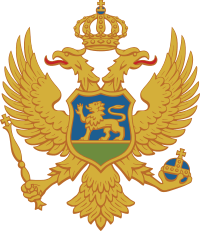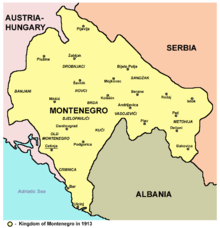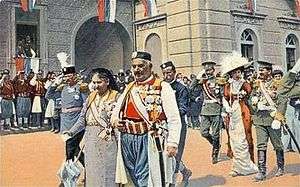Kingdom of Montenegro
| Kingdom of Montenegro | ||||||||||
| Краљевина Црнa Горa Kraljevina Crna Gora | ||||||||||
| ||||||||||
| ||||||||||
| Anthem Ubavoj nam Crnoj Gori Убавој нам Црној Гори "To Our Beautiful Montenegro" | ||||||||||
.svg.png) The Kingdom of Montenegro in 1914. | ||||||||||
| Capital | Cetinje (1910–1916) | |||||||||
| Capital-in-exile | Bordeaux, Neuilly-sur-Seine | |||||||||
| Languages | Serbian | |||||||||
| Religion | Eastern Orthodox (official) [1] | |||||||||
| Government | Constitutional monarchy | |||||||||
| King | ||||||||||
| • | 1910–1918 | Nicholas I | ||||||||
| Prime Minister | ||||||||||
| • | 1910–1912 | Lazar Tomanović (first) | ||||||||
| • | 1917–1918 | Evgenije Popović (last) | ||||||||
| Legislature | Parliament | |||||||||
| Historical era | World War I | |||||||||
| • | Proclamation | 28 August 1910 | ||||||||
| • | Balkan Wars | 1912–1913 | ||||||||
| • | Treaty of London | 30 May 1913 | ||||||||
| • | Balkans Campaign | 1914–1918 | ||||||||
| • | Corfu Declaration | 20 July 1917 | ||||||||
| • | Unification with Serbia | 28 November 1918 | ||||||||
| • | Creation of Yugoslavia | 1 December 1918 | ||||||||
| Area | ||||||||||
| • | 1910 | 9,475 km² (3,658 sq mi) | ||||||||
| • | 1912 | 14,442 km² (5,576 sq mi) | ||||||||
| • | 1917 | 620,000 km² (239,383 sq mi) | ||||||||
| Population | ||||||||||
| • | 1911 est. | 220,000 | ||||||||
| • | 1914 est. | 423,000 | ||||||||
| Currency | Montenegrin Perper | |||||||||
| ||||||||||
| Today part of | | |||||||||
Part of a series on the |
|---|
| History of Montenegro |
  |
| Prehistory |
| Middle Ages and early modern |
| Modern and contemporary |
|
|
The Kingdom of Montenegro (Serbian: Краљевина Црнa Горa / Kraljevina Crna Gora), was a monarchy in southeastern Europe, present day Montenegro, during the tumultuous years on the Balkan Peninsula leading up to and during World War I. Legally it was a constitutional monarchy, but absolutist in practice. On 28 November 1918, following the end of World War I, with its government still in exile, Montenegro was occupied by its former ally Kingdom of Serbia and illegally annexed by it, only to be merged into the Kingdom of Serbs, Croats and Slovenes three days later, on 1 December 1918.
History
Prince Nicholas of Montenegro proclaimed the Kingdom of Montenegro in Cetinje on 28 August 1910. King Nicholas I (as he became) had ruled the country as Prince since 1860, and had initiated several modernizing reforms at the beginning of the 20th century, such as introducing a constitution and a new currency, the Montenegrin perper.
Montenegro joined the First Balkan War in 1912, hoping to win a share in the last Ottoman-controlled areas of Rumelia. Montenegro did make further territorial gains by splitting Sandžak with Serbia on 30 May 1913. But the Montenegrins had to abandon the newly captured city of İşkodra (Skadar in Serbian, subsequently Shkodër) to the new state of Albania in May 1913, at the insistence of the Great Powers, despite the Montenegrins having invested 10,000 lives into the capture of the town (April 1913) from the Ottoman-Albanian forces of Esad Pasha.
When the Second Balkan War broke out in June 1913, Serbia fought against Bulgaria, and King Nicholas sided with Serbia. Once again Montenegro found itself tossed into war, in which it won substantial additional territory.
During World War I (1914-1918) Montenegro allied itself with the Triple Entente, in line with King Nicholas' pro-Serbian policy. Accordingly, Austria-Hungary occupied Montenegro from 15 January 1916 to October 1918.
On 20 July 1917, the signing of the Corfu Declaration foreshadowed the unification of Montenegro with Serbia. On 28 November 1918, Montenegrin unification with Serbia was proclaimed. Nicholas I had staunchly supported unification with Serbia to form a great Serbian state for all Serbs, but had disputed with the kings of Serbia as to who would rule the new kingdom. The Podgorica Assembly dethroned King Nicholas on 26 November 1918; he died in exile.
During World War II, the occupying forces in Yugoslavia considered turning the Italian governorate of Montenegro into a puppet kingdom, but nothing came of these plans.
Rulers
King of Montenegro (1910–1918)
- Nicholas I of Montenegro (1910–1918)
Pretenders (1918–present)
- Nicholas I of Montenegro (1918–1921)
- Danilo, Crown Prince of Montenegro (Danilo III) (1921)
- Michael, Prince of Montenegro (Michael I) (1921–1986)
- Prince Nicholas of Montenegro (Nicholas II) (1986–Present)
- Boris of Montenegro (Heir apparent) (born 1980)
Prime Ministers (1910–1916)
- Lazar Tomanović (1910–1912)
- Mitar Martinović (1912–1913)
- Janko Vukotić (1913–1915)
- Milo Matanović (1915–1916)
Prime Ministers in-exile (1916–1922)
- Lazar Mijušković (1916)
- Andrija Radović (1916–1917)
- Milo Matanović (1917)
- Evgenije Popović (1917–1919)
- Jovan Plamenac (1919–1921)
- Anto Gvozdenović (1921–1922)
- Milutin Vučinić (1922)
- Anto Gvozdenović (1922)
Gallery
 Kingdom of Montenegro in 1913.
Kingdom of Montenegro in 1913. Proclamation of the Kingdom of Montenegro, 28 August 1910.
Proclamation of the Kingdom of Montenegro, 28 August 1910.
See also
References
- ↑ Constitution of the Principality of Montenegro, 1905, Article 40, "Paragraph 1: State religion in Montenegro is Eastern-Orthodox. Paragraph 2: Montenegrin Church is Autocephalous. It is independent from any other Church, but maintains dogmatic unity with Eastern-Orthodox Ecumenical Church. Paragraph 3: All other recognized religions are free in Montenegro.
Further reading
- Živojinović Dragoljub R. (2014). "King Nikola and the territorial expansion of Montenegro, 1914-1920". Balcanica. 45: 353–368.
External links
 Media related to Kingdom of Montenegro at Wikimedia Commons
Media related to Kingdom of Montenegro at Wikimedia Commons- Kingdom of Montenegro in 1918
- Map
- Map
- Montenegro - World Statesmen
| Timeline of Yugoslav statehood | |||||||||||
|---|---|---|---|---|---|---|---|---|---|---|---|
| Pre-1918 | 1918–1929 | 1929–1945 | 1941–1945 | 1945–1946 | 1946–1963 | 1963–1992 | 1991/1992–2003 | 2003–2006 | 2006–2008 | 2008– | |
| Slovenia | See also Kingdom of Croatia-Slavonia 1868–1918 Kingdom of Dalmatia 1815–1918 Condominium of Bosnia and Herzegovina 1878–1918 |
See also Banat, Bačka and Baranja 1918–1919 Italian province of Zadar 1920–1947 |
Annexed bya Fascist Italy and Nazi Germany |
Democratic Federal Yugoslavia 1945–1946 Federal People's Republic of Yugoslavia 1946–1963 Socialist Federal Republic of Yugoslavia 1963–1992 Consisted of the Socialist Republics of |
Ten-Day War | ||||||
| Dalmatia | Independent State of Croatia 1941–1945 Puppet state of Nazi Germany. Parts annexed by Fascist Italy. Međimurje and Baranja annexed by Hungary. |
Croatian War of Independence | |||||||||
| Slavonia | |||||||||||
| Croatia | |||||||||||
| Bosnia | Bosnian War Consists of the Federation of Bosnia and Herzegovina (1995–present), Republika Srpska (1995–present) and Brčko District (2000–present). | ||||||||||
| Herzegovina | |||||||||||
| Vojvodina | Part of the Délvidék region of Hungary | Autonomous Banatd (part of the German Territory of the Military Commander in Serbia) |
Federal Republic of Yugoslavia | State Union of Serbia and Montenegro | |
Includes the autonomous province of Vojvodina | |||||
| Serbia | Kingdom of Serbia 1882–1918 |
Territory of the Military Commander in Serbia 1941–1944 e | |||||||||
| Kosovo | Part of the Kingdom of Serbia 1912–1918 |
Mostly annexed by Albania 1941–1944 along with western Macedonia and south-eastern Montenegro |
| ||||||||
| Metohija | Kingdom of Montenegro 1910–1918 Metohija controlled by Austria-Hungary 1915–1918 | ||||||||||
| Montenegro | Protectorate of Montenegrof 1941–1944 |
| |||||||||
| Macedonia | Part of the Kingdom of Serbia 1912–1918 |
Annexed by the Kingdom of Bulgaria 1941–1944 |
| ||||||||
|
| ||||||||||
Coordinates: 42°38′00″N 19°32′00″E / 42.6333°N 19.5333°E

